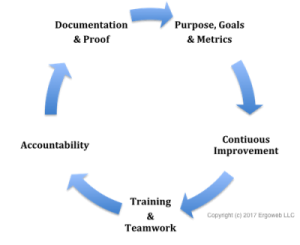Sustainable sounds like one of those corporate buzzwords that come and go, but the meaning behind it will always ring true for organizations purposely built to survive, improve and thrive into the future. Ergonomics plays a key role in corporate sustainability, and this article provides an overview for a sustainable ergonomics in the workplace.
Eighty-five percent of the reasons for failure are deficiencies in the systems and process rather than the employee. The role of management is to change the process rather than badgering individuals to do better.1
W. Edwards Deming, corporate sustainability pioneer
The 5 Requirements for Sustainable Ergonomics in the Workplace
- Purpose and Goals
- Training
- Metrics and Continuous Improvement
- Documentation and Proof
- Teamwork and Accountability
Workplace Ergonomics Purpose, Goals & Strategy
- Prevent injuries, fatigue and discomfort
- Reduce the severity of injuries, disabilities, and all associated costs
- Improve production quality and workmanship
- Improve efficiency and productivity
- Improve moral, accountability, teamwork and cross-functional cooperation
- Improve absenteeism and turnover rates
 Strategy is the method and means you apply to meet your production goals. It’s important to set realistic goals, then set your strategy in motion with specific timelines and metrics aligned to achieve success. SMART-A is an acronym that may help you as you devise your ergonomics process strategy.
Strategy is the method and means you apply to meet your production goals. It’s important to set realistic goals, then set your strategy in motion with specific timelines and metrics aligned to achieve success. SMART-A is an acronym that may help you as you devise your ergonomics process strategy.
Ergonomics can benefit other corporate functions, including product and service design, but this article focuses only on workplace ergonomics.
Ergonomic Metrics and Continuous Improvement
- Lagging metrics measure outcomes that have already occurred
- Leading metrics measure factors that predict outcomes before they occur
- The more mature your process is, the more you identify and rely on leading metrics
- reports of work-related fatigue and discomfort
- first-aid treatment for work-related aches and pains
- documented ergonomics-related injuries, rates and costs
- ergonomics-related Workers’ Comp data
- costs associated with injured return-to-work
- costs associated with ineffective (non-root-cause) fixes to problems
Example leading metrics for the impact of ergonomics on health and safety:
- Quantified risk factors like forceful exertions, repetition, awkward posture, and duration of exposure
Example lagging quality metrics for the impact of ergonomics on process quality:
- Error or reject rates for specific process-steps involving human interactions and inputs
- Quality control errors involving visual inspection or other human interactions
- Yield, the percentage of correctly manufactured product without scrap or rework
Example leading metric for the impact of ergonomics on process quality:
- # of defects/quality problems identified and controlled during production (as opposed to after production)
Example metrics for the impact of ergonomics on process efficiency:
- Throughput, or productivity over a given time period
- Cycle times
Ergonomics in the Workplace: Training
No goal, regardless of how small can be achieved without adequate training.2
Taiichi Ohno, corporate sustainability pioneer
- The expected value, benefits and outcomes of a sustainable ergonomics process
- An overview of the 5 Requirements
- General ergonomics awareness training appropriate for their role in the company
- Metrics and process fundamentals
- A deep-dive focus on their particular roles and responsibilities in the process, particularly as they relate to identification, evaluation, tracking and implementing fixes and improvement opportunities.
- Top Management: The business purpose, benefits and strategy of the ergonomics process, and the importance of their commitment and leadership toward those goals.
- Mid-Management: General ergonomics awareness, their roles, rights and responsibilities to foster a continuous improvement environment, leadership towards the ergonomics process goals, how to track and evaluate improvements from a recognized set of consistent metrics, and encourage innovation and improvement processes to thrive.
- Employees and supervisors: General ergonomics awareness, their roles, rights and responsibilities in the overall ergonomics process and the Plan-Do-Check-Act activities, and how to identify, evaluate, and improve the design of workstations, equipment and production processes on a daily basis.
Teamwork and Accountability
Ergonomics is no different than any other improvement management strategy. The process can only succeed if people understand and execute their respective roles and responsibilities. Without individual accountability and the ability to effectively cooperate, no improvement process is successful in the long term.
Conclusion
Ergonomics is an essential tool for organizations that are built to last. Maintaining an ergonomics process that encompasses the five requirements described above is an important ingredient in the recipe for sustainability.
References
- W. Edwards Deming, http://www.azquotes.com/quote/873755
- Taiichi Ohno, http://www.azquotes.com/quote/1411460

